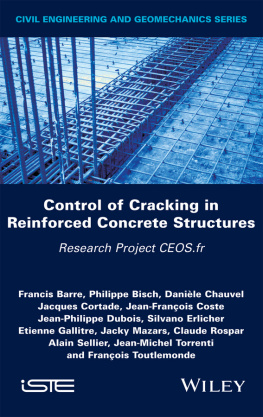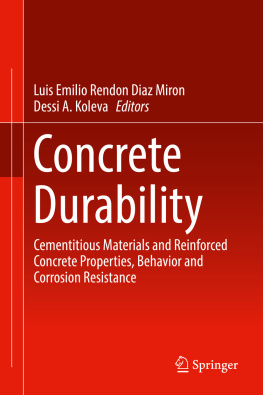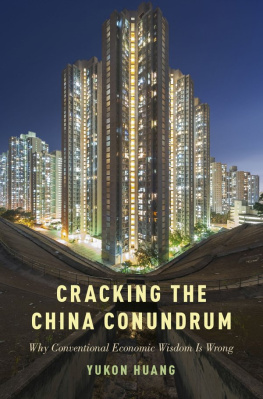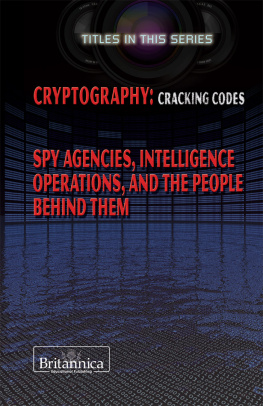
Series Editor
Jacky Mazars
Control of Cracking in Reinforced Concrete Structures
Research Project CEOS.fr
Francis Barre, Philippe Bisch, Danile Chauvel, Jacques Cortade, Jean-Franois Coste, Jean-Philippe Dubois, Silvano Erlicher, Etienne Gallitre, Pierre Labb, Jacky Mazars, Claude Rospars, Alain Sellier, Jean-Michel Torrenti, Franois Toutlemonde
First published 2016 in Great Britain and the United States by ISTE Ltd and John Wiley & Sons, Inc.
Apart from any fair dealing for the purposes of research or private study, or criticism or review, as permitted under the Copyright, Designs and Patents Act 1988, this publication may only be reproduced, stored or transmitted, in any form or by any means, with the prior permission in writing of the publishers, or in the case of reprographic reproduction in accordance with the terms and licenses issued by the CLA. Enquiries concerning reproduction outside these terms should be sent to the publishers at the undermentioned address:
ISTE Ltd
27-37 St Georges Road
London SW19 4EU
UK
www.iste.co.uk
John Wiley & Sons, Inc.
111 River Street
Hoboken, NJ 07030
USA
www.wiley.com
ISTE Ltd 2016
The rights of Research Project CEOS.Fr to be identified as the authors of this work have been asserted by them in accordance with the Copyright, Designs and Patents Act 1988.
Library of Congress Control Number: 2016941705
British Library Cataloguing-in-Publication Data
A CIP record for this book is available from the British Library
ISBN 978-1-78630-052-2
Foreword
The control of cracking in reinforced and prestressed concrete is an essential factor in ensuring the reliability and durability of structures, together with many other important properties including water-tightness and air-tightness.
Eurocode 2 (EC2) and, more recently, fib Model Code 2010 (MC2010) address the durability of structures and contain guidelines and rules for estimating and limiting cracking as a function of the characteristics of concrete and its reinforcement, and the exposure classifications of the works. However, these rules are normally only intended to be applied to the most common design situations. As a result, they do not take sufficient account of the behaviour of works containing massive reinforced and prestressed concrete structures, nor works which are subject to special service requirements in terms of water-tightness and air-tightness or service life and so forth. These rules are also inadequate for works requiring enhanced load protection against natural hazards or external attack. In these works, thermo-hydro-mechanical (THM) effects, scale effects and structural effects can all result in specific cracking behavior. In the case of thick rafts and walls, shrinkage and creep shall be taken into account, both in early-age concrete and in the long-term.
The purpose of this book is to provide further guidelines which can extend the existing standards and codes to cover these types of special works, especially those which are massive in nature, taking account of their specific behavior in terms of cracking and shrinkage together with other important properties such as water- and air-tightness.
The proposed rules and guidelines given in this book are based on the results of the French CEOS.fr project (Comportement et Evaluation des Ouvrages Spciaux fissuration, retrait) covering the behavior and evaluation of special reinforced concrete (RC) works with regard to cracking and shrinkage. The CEOS.fr project took place between 2008 and 2015, involving 41 French Ministre de lEnvironnement de lnergie et de la Mer (MEEM), clients and project managers. The project was funded jointly by the partners of the MEEM.
The CEOS.fr project consisted partly of tests, some using full-scale solid concrete blocks and others performed on a smaller scale using laboratory models, together with the development of simulation models in collaboration with the MEFISTO project under the auspices of the French Agence Nationale pour la Recherche (ANR). The experimental results were presented to the international scientific community and a panel of experts in these complex and rapidly changing fields assessed the simulation models. The CEOS.fr project also took account of experimental results and actual experience feedback of concrete works from the various partners.
These guidelines are addressed primarily to designers and civil engineers responsible for construction projects. Engineering rules and recommendations are illustrated at the end of each chapter using examples of design calculations, commentary on the use of models, or applicable measurement methods. Further supporting details of the basis for these guidelines may be found in the CEOS.fr test report, titled Results obtained in the understanding of cracking phenomena [PN 13b], which describes the results of the associated tests, the interpretation of these results and the justifications for each proposed modification to EC2 and MC2010.
The guidelines given herein reflect the latest state of the art understanding at the time of going to press. They are therefore subject to expansion and modification as new experimental data becomes available, further experience is gained and new technologies are used in future projects.
We would like to express our sincere thanks to all those who have contributed to the publication of this document, its English version and to the, Institut pour la recherche applique et lexprimentation en gnie civil (IREX) for their administrative and logistical support.
Pierre LABB, EDF
December 2015
Matrise durablE de la Fissuration des InfraSTructures en btOn.
Notations
Symbols are mentioned only when they are specific and not used currently by Eurocode 2 (EC2) [NF 04, NF 06a, NF 06b] and fib model code 2010 (MC2010) [CEB 12]. However some symbols used less in these codes are also quoted. The units refer to the International System (IS).
| Chapter | Symbol | Description | Unit |
Tmax
Tini | Temperature differential at a given point between the maximum temperature reached by concrete during its setting and its initial temperature | C |
| Tadiab | Adiabatic temperature | C |
| Thermal conductivity | W1.m1.K1 |
| Q | Hydration heat per weight unit of cement | kJ.kg1 |
| C | Heat capacity per weight unit of concrete | kJ.kg1.C1 |
| a | Diffusivity | m2.s1 |
| T | Reduction coefficient of temperature rise calculated in accordance with adiabatic conditions:
 | () |
| cm | Mean value of concrete compressive strength | MPa |
| fctm,scale | Mean value of concrete axial tensile strength taking account of scale effect | MPa |
 | Mean value of concrete axial strength taking account of scale effect, calculated according to Weibull approach | MPa |
| Vref | Volume loaded by a direct tensile test that characterizes the ultimate tensile strength | |
Next page












